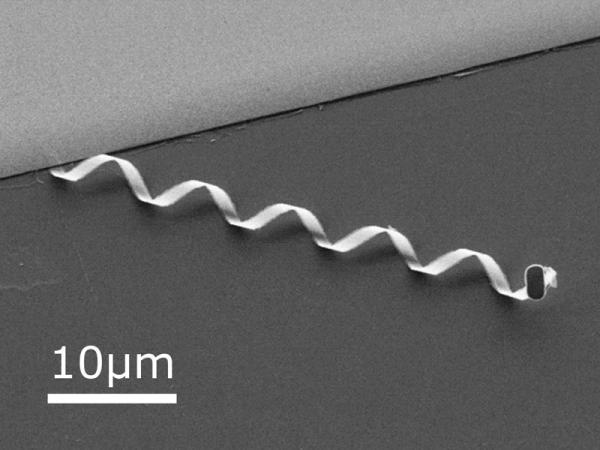In our last blog we introduced HeartLander, a device that when inserted into the chest cavity can deliver medication, ablation therapy and provide assistance in lead placement for pacing the heart muscle. HeartLander’s developers hope to shrink it to 3 millimetres from its current size, 8.5 mm. Devices of this type represent the start of a new use of robotic devices built to operate autonomously within a human body. We’ll look at where the technology is today and what we can expect in the near future.
In the world of internal medical robots HeartLander is a giant. Researchers have much smaller in mind when they conjure up micro-robot designs. These researchers develop robots on a nanoscale. We have broached this subject before in a blog and stated at the time of writing that there were no existing biomedical nanobots. That remains true but researchers at ETH Zürich have been building what they call micro-robots that are bacterial-scaled measuring lengths of between 5 and 15 nanometers. Called Artificial Bacterial Flagella or ABF for short, these devices swim like bacteria with corkscrew tails.

Made by depositing vaporized indium, gallium, arsenic and chromium onto a surface substrate a few atoms thick, the ABFs are patterned using lithography and etching. When thin sliced they naturally form the curled ribbon corkscrew you see in the picture above. The ABF head seen on the right contains a tri-layer film of chromium, nickel and gold. Nickel’s magnetic properties make it possible to use an external magnetic field to provide locomotion. The ABF uses helical propulsion (the same method of locomotion used by many bacterium) to swim through liquid at speeds of up to 20 nanometers at present with plans to increase it to 100 nanometers. Compare that to E. coli which swims at 30 nanometers per second.
To give ABFs autonomous power researchers are looking at thin-film rechargeable batteries. Currently these batteries can be manufactured and shaped with thicknesses of less than 50 nanometers. Chemical fuel sources may prove to be even more promising. An ABF running on energy it harvests from the blood would be capable of running indefinitely within a body harvesting glucose and oxygen to provide motive and computing power. Some researchers are looking at using bacteria as an ABF, modifying a living cell by attaching nanoparticles to it so that it can be mobilized for biomedical purposes.
What can ABFs do that current biomedical technology cannot?
- Targeted delivery of drugs to a specific area in the body reducing the total risk to the body of side effects. This kind of therapy can even be sub-cellular, delivering medicine to alter genes within a chromosome.
- Placement of radioactive seeds near tumor cells. Called brachytherapy, targeted radiation therapy delivers a killing dose only to selected cells, leaving healthy cells alone.
- Delivering heat therapy called thermoablation to selected cells to destroy them without damaging healthy surrounding tissue. The ABF’s magnetic properties would prove useful for this type of therapy.
- Implanting of stem cells using the ABF as the carrier. Stem cells could then be delivered to an area of the body to regenerate hearing, site, organs and bones.
- Collecting tissue samples for biopsy. The ABF would excise a small sample and when excreted or removed from the body allow for quick on-the-spot analysis to determine if cancer is present.
- ABFs could be used as scaffolding material similar to the way stents are used today. But the ABF scaffolding would be on a nanoscale to act as cellular building blocks for regrowing blood vessels, nerves and organs. As small as today’s stents are, an ADF could act as a stent in the smallest of blood vessels, or a group of them could be combined to form a larger scaffold.
- ABFs could be used to block or occlude blood vessels feeding a tumor causing the tumor to starve and die.
- ABFs with specialized implanted electrodes could be used to restore severed nerves in a spinal column or provide neural connections to reverse brain damage.
- Remote sensing represents one of the most promising uses of ABFs. An ABF could be packed with instrumentation to measure blood-oxygen levels, arterial flow, blood pressure and other vital signs instantly transmitting the results to external monitors.
- ABFs introduced into a patient suffering from multiple injuries could hover at sites where organ damage or internal bleeding has been identified and constantly provide status updates to physicians dealing with the emergency.
- Fetal surgery represents a promising field for the use of ABFs, providing doctors with the means to correct congenital heart defects in utero, or performing ablation therapy to deal with congenital malformations, or clearing obstructions in blood vessels and the urinary tract, or replacing needles to collect samples for amniocentesis and other fetal tests
Currently ABFs are confined to the research laboratory. But soon we will microscopically see these devices applied to all kinds of medical procedures reducing the need for surgical procedures, minimizing the side affects of cancer chemotherapy, and giving biomedical professionals a new set of tools for tackling conditions for which current medical practice has few solutions.
For those developing this technology it’s a question of tinkering with the power source to come up with the best way to deploy micro-robots.















